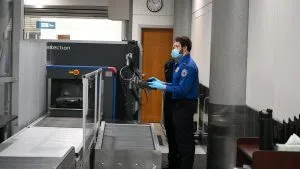GREEN BAY, WI (WTAQ) – Thanksgiving travelers might have something new to be thankful for, as new technology being implemented by the Transportation Security Administration (TSA) is set to speed up the process at Green Bay Austin Straubel International Airport.
Usually, dealing with the TSA isn’t exactly the most exciting experience. But new computerized tomography (CT) baggage scanners are making that process a bit less painful.
“Creating a 3D image that can be viewed and rotated 360-degrees by our TSA officers. This results in significantly improved imagery of a passengers carry on bag and their contents,” said Federal Security Director for TSA in Wisconsin Mark Lendvay. “It allows the X-Ray operator to actually look at an item of interest inside the carry-on through the use of the mouse, rotate the image, and then what we call slice and dice.”

TSA officers look at the contents of a bag using the CT scanning security process. (PHOTO/WTAQ News)
Lendvay considers it the most advanced technology available for TSA passenger screening checkpoint operations, comparing it to the medical grade equipment -where most people might recognize the CT scanning process. It gives officers an extra dimension to look at, along with different analysis of what the contents of a bag might be holding.
“Explosives have a lot of density, so the officers are trained to look for that. It allows the officer to then step further, beyond the older technology, to be able to do that. In most cases, they would have to just send the back for secondary inspection,” Lendvay explained. “It’s better screening to detect, I’ll say increased threats. But then there’s an efficiency piece, because we’re not having to unpack and pack the bag when we’re done screening.”
The CT scans not only improve the security aspect of the interaction, but also reduces the number and frequency of physical inspections. With concerns still high surrounding the pandemic, that removal of touchpoints could mitigate some worries for travelers as well. There’s also a major convenience factor that could keep the process moving quickly even long after COVID concerns are gone.
“With the pandemic, us not having to go in every bag as we traditionally have done, it’s a good thing. Plus it allows a passenger to keep everything everything inside their bags, where traditionally the laptop, iPads, toiletries would have to come out,” Lendvay told WTAQ News. “You’ve all traveled and seen that individual with an overstuffed bag who may need three or four bins to get through. Now, they’re just taking that carry-on bag and putting it in the bin and it’s going through.”
However, travelers will still be required to remove jackets and shoes before going through the security checkpoint themselves. That is, unless you go through the TSA PreCheck process.
Physical inspections of carry-on bags will still occur if an officer is on able to clear an alarmed item. However, TSA anticipates that the frequency of physical inspections will be reduced overall.
Lendvay says there is currently a nationwide contract of $96.8 million to implement similar technology at airports across the country. The units are approximately $300,000 each, including ancillary equipment and services for five years. The TSA is working to replace 2,200 units at 434 airports nationally. That includes the Eau Claire, Rhinelander, LaCrosse, and Central Wisconsin terminals. Milwaukee, Madison, and Appleton already have them.






Comments